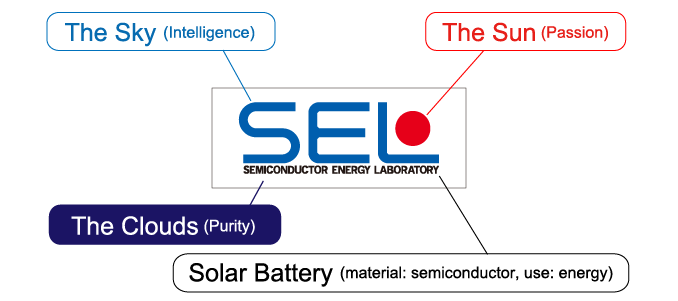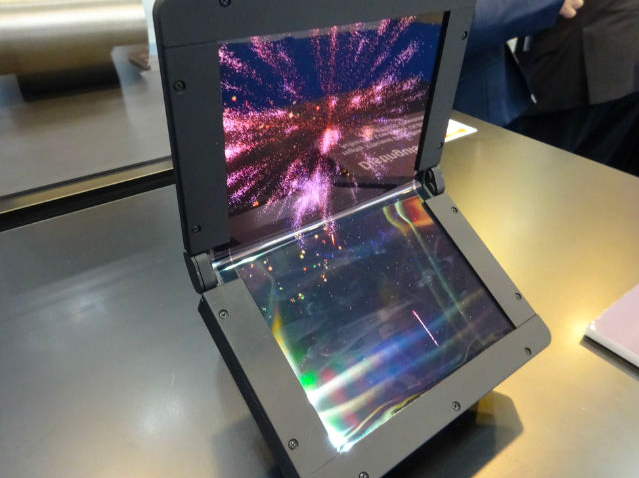New 8K OLED Displays for Tablets and Laptops: 8.3 and 13.3 Inches
by Anton Shilov on December 21, 2018 1:00 PM EST
Semiconductor Energy Laboratory, a technology developer from Japan, has developed the industry’s first 8.3 and 13.3-inch OLED displays featuring an 8K resolution. The monitors use crystalline oxide semiconductor technology and they are likely preliminary designs for future product commercialization. The company also recently showcased a bendable 8.6-inch OLED panel, potentially for a foldable tablet or smartphone.
| Size | Resolution | PPI | Refresh Rate |
Bendy |
| 8.3-inch | 7680 x 4320 | 1062 | 60 Hz | - |
| 13.3-inch | 7680 x 4320 | 663 | 120 Hz | - |
| 8.6-inch | 1900 x 1200 | 263 | 60 Hz | Yes |
Both of SEL’s OLED panels featuring a 7680×4320 resolution use a color filter that relies on CAAC-IGZO (c-axis aligned crystalline indium gallium zinc oxide) material. The 8.3-inch 8K panel can boast with a rather high pixel density of 1061 pixels per inch and has a refresh rate of 60 Hz. The larger 13.3-inch 8K panel features a pixel density of 662 PPI, but has a refresh rate of 120 Hz, which is particularly high for an OLED. The 8.3-inch 8Kp60 OLED was demonstrated last month at SEMICON Japan, whereas the 13.3-inch 8Kp120 OLED currently exists only in SEL’s labs.
The 8.3-inch display is 1062 PPI. For comparison, Sony's Z5 Premium with a 5.5-inch display and 4K resolution was 801 PPI. At 8.3-inches, it's a little big for a smartphone, so it will be interesting if that size can come down a little bit. 8K at 6.5-inches would be 1355 PPI, so the power draw would be quite interesting.
Other notable developments of SEL include a foldable 8.6-inch OLED panel with an 1920×1200 resolution rated for 10,000 bend/unbend cycles (that is 27.4 folds per day over a year) as well as OLED panels capable of displaying the BT.2020 color space.
The primary focus of Semiconductor Energy Laboratory’s work is development of crystalline oxide semiconductor technologies for various applications including chips and displays. CAAC-IGZO is recognized as one of next-generation materials that enable high-resolution low-power displays, so SEL is working on its practical implementations. Being an IP-licensing company, SEL does not have its own production capacities, so it will need a partner to make CAAC-IGZO-based 8K OLEDs a reality.
Related Reading
- Samsung Begins Sales of 65-Inch Q900R 8K UHDTV in the UK
- Samsung Starts to Take Pre-Orders on 85-Inch Q900 8K UHDTV
- Samsung’s One Invisible Connection: 75 Gbps and 230W in a Ultra Thin Cable
- Sharp’s 8K UHD TV Available in Japan, Listed in Europe for €11,899
- Sharp Announces 2nd Gen 8K UHD TVs at IFA
- AUO to Ship 8K UHD TV Panels in Coming Months
- Philips Demos 328P8K: 8K UHD LCD with Webcam, Docking, Coming in 2018
- Dell’s 32-inch 8K UP3218K Display Now For Sale: Check Your Wallet
Source: Optronics Online












59 Comments
View All Comments
aenews - Monday, December 31, 2018 - link
I owned a Pixel-C for much of this year though I've converted to a Tab S4 as of late since it has an absolutely fantastic OLED display. I definitely would love to have at least 4K at that screen size. If you're used to having QHD on a phone then this is insufficient on a tablet. Plain and simple. Looking forward to new technology. I have a 4K laptop, but I actually watch content on my tablet as it's more convenient. With a 4K+ tablet, I'd be able to watch 4K content natively. It's well worth the higher resolution as you can always adjust the distance between the tablet and your face.wolrah - Friday, December 21, 2018 - link
A derivative of the 8" panel's technology could be useful in a future high-end VR product. The 13" panel is in the same PPI ballpark as the Vive Pro and Samsung Odyssey.As actual laptop or tablet displays though, I doubt there's actually a useful purpose. At normal viewing distances I find it hard to believe these would be distinguishable from 4K, especially in the 8" size. I'm a believer in the idea of smoothing at sub-visible levels being useful to a point, but even 4K in a 13" laptop seems to be pushing the limits of utility unless you spend your life in a coach seat with the screen 10 inches from your face.
I am curious what the subpixel configuration is of course. I'll be amazed if the small one is RGB. Probably Pentile or similar.
LordanSS - Friday, December 21, 2018 - link
An 8k OLED panel with low persistance at 90Hz would be a big boon for VR products. We'd be one step closer to removing the screen-door effect.haukionkannel - Sunday, December 23, 2018 - link
Yep!Really usefull! Ofcourse we need more gpu power for that but even 4K is too Little for VR 8 to 16k could be enough...
mukiex - Sunday, December 23, 2018 - link
My thoughts exactly. The 120hz 8K 13.3 inch screen, depending on how they manufacture it, might be scalable on a new line in the future to a 120hz 4K 6.65 inch VR display.Or cut it in half for a 7680x2160 display across both eyes (~3800x2160 per eye) @ 120hz. I'm really hoping we do see something of that nature in the future. SDE would be gone if the Pimax coverage is any indication.
mukiex - Sunday, December 23, 2018 - link
Actually, lemme backtrack on that last one a bit; the Pimax doesn't look quite as good at release as it did when they showed it off: https://imgur.com/a/eJNXqJ8We'll continue to see improvements with higher resolutions but I don't think we're at elimination yet.
aenews - Friday, December 21, 2018 - link
If Pentile, then the higher resolution makes more sense. Though 8K is still excessively high, I'm sure there will be a level of euphoria that'll make it enticing.I'd say 4K is needed for laptops. Since the displays are larger, lower resolutions are noticeably less sharp.
ZolaIII - Friday, December 21, 2018 - link
Well those are still OLEDS & all do we still don't know the matrix used I wouldn't be surprised that it turns out to be Pentile so 13.3" ones PPI could be in the margins of what's visually recognisable...rtho782 - Friday, December 21, 2018 - link
even smaller and even higher would be good for VRxTRICKYxx - Friday, December 21, 2018 - link
60hz though :(